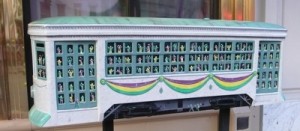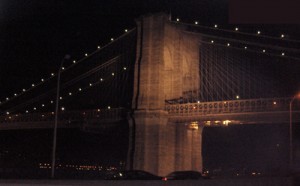As we prepare for this winter season, many small businesses are still recovering from the last winter. The deadline is fast approaching for small businesses impacted by last season’s winter storms (specifically, those that struck New England between January 28 to 28) to apply for the low-interest Economic Injury Disaster Loans of the U.S. Small Business Administration. The same deadline applies for SBA EIDL applications for small businesses (“private non-profit organizations” is the term the SBA uses) in Tennessee that were impacted by the severe winter storms and flooding that occurred on February 15 – 22, 2015. Insuring against storm-related losses is generally more cost-effective than borrowing to finance the losses after the storm has occurred. Now is the time to review your insurance policy to make sure that your coverage will protect your business this winter.
Archive for the ‘Recovery’ Category
Recovering From Last Winter, Preparing for the Next One
Tuesday, December 8th, 2015Anniversary of the Tōhoku Earthquake and Tsunami
Wednesday, March 11th, 2015Today marks the fourth anniversary of the 2011 Tōhoku Earthquake and Tsunami, also known as the Great East Japan Earthquake, the most powerful earthquake ever recorded in Japan and the fourth most powerful earthquake in the world, since 1900 when earthquake measures were first recorded. The earthquake triggered a tsunami that struck Sendai and caused an accident at the Fukushima Nuclear Power Plant. More than 15,000 people died and millions of Japanese households were left without water and power. The World Bank believes that the losses resulting from the earthquake and tsunami reach US$235 billion, making it the most expensive disaster in history.
Among the projects to provide ongoing community support are the handcrafted linens produced by T. Kawabe & Co., Ltd., a well-known maker of towels in Japan. This photograph shows the “Charity Bear” made from a Kawabe cotton towel featuring a heart design licensed from the French company Ladurée and folded in the shape of a bear. Kawabe started this project two years ago and the towels are made and folded by fifty or so people who are living in temporary shelter since being placed by disaster. Kawabe hopes that this project will support joy and hope for renewal and rebuilding. You can support their efforts by purchasing these items on various online sites. I bought mine on eBay.
Effects of the Oil Spill on Children
Sunday, October 17th, 2010The BP oil spill is responsible for health problems and financial hardship for Gulf Coast residents that may continue well after the cleanup work is finished, according to a team of researchers at the National Center for Disaster Preparedness at Columbia University’s Mailman School of Public Health. The researchers found that one in five residents surveyed earn less money now than before the spill; 8% of the 1,200 people surveyed lost their jobs. Households with incomes of less than $25,000 suffered the greatest economic impact. The economic stress felt by the parents trickles down to the children; one-third of the parents surveyed reported that their children have become anxious or depressed since the oil spill occurred. In addition to the psychological stress, medical problems, such as respiratory ailments and skin irritations, are related to the spill. The Children’s Health Fund is sending mobile pediatric units to help. “There are literally no pediatricians in the lower two-third of Plaquemines Parish, Louisiana, one of the worst-hit areas,” according to Irwin Redlener MD, the lead researcher of the National Center on Disaster Preparedness. Sadly, these difficulties appear likely to continue long after the disaster has receded from the newspaper headlines. As a society, we have not yet come to grips with the long-term needs of disaster recovery.
SBA Recovery Loans Perform as Predicted
Saturday, September 4th, 2010On March 23 of last year, I posted a blog entry critical of the America’s Recovery Loan Program of the U.S. Small Business Administration. Specifically, I wrote that to mitigate the moral hazard risk (inherent in raising federal government loan guarantees), the SBA stipulates that the loans “are to be extended only to ‘viable’ small businesses, which it defines as those that have ‘demonstrated an earnings history and a proven record for success that may just need a little extra help to get through a short-term downturn’. (Shouldn’t all loans be limited to ‘viable’ businesses? And how did the SBA determine that the current economic downturn will exist only for the ‘short-term’?)”
On June 17, 2009, I posted a follow-up entry to write that there may be relatively few qualified applicants to apply for this program given its unusual requirements and that banks would not likely find the 2 percent premium paid by the government sufficient compensation for the onerous underwriting requirements.
Here we are a year later. The Recovery Loan program expires this month and the SBA has approved just fewer than 8,300 loans, even less than the modest number (10,000) of loans that the SBA had funds available to support. The New York Times has reported that meeting the “struggling but viable” criteria proved difficult for small businesses and banks had little appetite for the extensive underwriting requirements. When you contrast this lame “recovery” program with the Troubled Assets Relief Program (TARP) that bailed out Wall Street, it makes it clear where Congress’ priorities lie.
Helping the Gulf Coast Tourism Industry
Monday, July 26th, 2010The U.S. Travel Association reports that as many as 400,000 travel industry jobs could be lost as a consequence of the oil spill in the Gulf Coast. The total potential cost of the spill to the Gulf Coast tourism industry is estimated at $22.7 billion with most of those losses, as much as $18 billion, likely to occur in Florida. “Travel is a perception business and the impact of disasters like the BP oil spill on the industry is actually predictable,” said Roger Dow, president and CEO of the U.S. Travel Association in a press release. “We know from this research that the oil spill will have long-term effects on businesses and jobs in the Gulf Coast region unless we counteract the usual course of events with an unprecedented response.” The U.S. Travel Association is calling for a $500 million marketing campaign to encourage tourists to return to the Gulf.
Although I oppose spending federal government money to market and promote any industry, I do agree that it makes sense for the U.S. Commerce Department to create travel-related trade missions to encourage international tourists to visit the Gulf. That could certainly be done at low cost. The risk of advocating for tax credits to promote Gulf Coast tourism is that the effort could take tourist business from other parts of the U.S., thereby undermining broad public support for Gulf Coast rebuilding. The high unemployment rate hurts the tourist industry everywhere; unfortunately, the oil spill exacerbates this weakness for the Gulf of Mexico.
Another Blow to Louisiana
Monday, July 19th, 2010There is never a good time to lose 5,000 jobs, but for Louisiana, the news that Northrop Grumman Corp. will close its Avondale shipyard (near New Orleans) could not have come at a worse time. Industries critical to the state’s economy – oil and gas, tourism, fishing – are devastated by the oil spill. Now with the closure of shipyards, the manufacturing industry comes under pressure as well. The 5,000 jobs to be eliminated include engineers, welders, pipefitters and other manufacturing positions that paid annual salaries of $62,000, on average. New Orleans is also facing hundreds of job eliminations at the Michoud Assembly Center, which employs workers from Lockheed Martin. The closures are the consequence of economic pressure for cost efficiency, unrelated to the oil spill. But the consequences are far-reaching as entire service industries support these facilities. In Lower Manhattan, we are all too familiar with this phenomenon: the financial crisis in the fall of 2008 resulted in substantial reductions in the New York banking workforce which, in turn, crippled small businesses that served those workers. You need only see the restaurant closings in the neighborhood to appreciate the ripple effect of the pain. And as we also know from our experience in New York, when a Fortune 500 company leaves, it typically transfers its financial support to other local charities in the communities where it maintains a presence. Reductions in the presence of Fortune 500 companies in New York impacted local charities that depended on those companies for grant support. What I find so upsetting about the experiences of communities facing disasters is that there appears to be no national learning taking place. We suffer needless pain, over and over again, as we experience the same losses from one community to the other. For a country with the diversity and richness of experience as ours, this is unacceptable.
New Ban on Offshore Drilling
Friday, July 16th, 2010The residents of the Gulf Coast states remain in limbo as their economic future will once more be debated in court. After its ban on deepwater offshore drilling was struck down by a Louisiana judge, the White House imposed an even more extensive ban. The original moratorium banned deepwater drilling, defined as drilling in waters of more than 500 feet in depth. The courts struck down the ban on the ground that it was arbitrary and exceeded the scope of executive authority. The new moratoriums imposed by Interior Secretary Salazar, acting on behalf of the Obama administration, applies to any deep-water floating facility with drilling activities, irrespective of depth. The ban imposes considerable hardship on the Gulf Coast states, as the local economy depends upon the oil industry. CNN estimates the oil industry in the Gulf Coast to contribute $150 billion annually to the local economy, well in excess of the tourism industry. And of course, this ban comes at a time when the fishing industry is already suffering the consequences of the oil spill. Public concerns about risk management protocols must be addressed, but an outright ban fails to do that while imposing considerable hardship on communities that are already suffering.
At Last?
Tuesday, January 26th, 2010Over eight years of negotiations over the fate of the former Deutsche Bank Building may be coming to an end. The building, located at 130 Liberty Street, faces the World Trade Center and became a serious environmental hazard on September 11, 2001. Now the Lower Manhattan Development Corp. (LMDC), established to oversee the reconstruction of the community following the terrorist attacks, may be close to resolving the expense of the building’s decontamination. Since 9-11, the building has been covered by a dark tarp to limit airborne contaminants of soot and ash released when the World Trade Center burned to the ground. Community activists opposed the proposed demolition of the building for fear of health effects to the local residents. Instead a compromise was negotiated: a staged decontamination and demolition process. But the process appeared jinxed as it dragged on for years, marred by horrific accidents and costly delays. In 2007, a fire broke out in the building, claiming the lives of two firemen. The building contractor admitted to wrongdoing in respect of its practices. The delays caused the costs of building decontamination to reach in excess of $200 million, provoking protest from the building’s insurers. The insurance companies have an excess of loss agreement in place to cover the decontamination costs. But the manner in which those costs have escalated necessarily gives rise to disputes over payments due. The LMDC and the insurance companies are reportedly close to concluding a financial settlement. Now comes the next round of disputes: what to do with any payments in excess of building remediation costs? Various groups are lobbying for their share of the spoils. Imagine what misery continues to exist for the residents and small businesses of disaster-ravaged communities who just want to put the tragedy behind them and get on with their lives.
The Tragedy That Never Ends
Sunday, April 19th, 2009For the small businesses that are based in Lower Manhattan in the vicinity of the World Trade Center site, and for the families that also live there, there is no end in sight. The ongoing reconstruction of the site, the round-the-clock noise and disruptions and concerns about environmental hazards (coupled with an extraordinary process for the demolition of 130 Liberty Street, the office building opposite the WTC) should have ended years ago. The endless and inexplicable delays prolong emotional trauma that should be healed and needlessly disrupt lives. It is an abuse of the residents and small businesses and an abuse of the American taxpayers who are underwriting this farce. Today there was another unwelcome but not, given the history, unexpected, development.
The Associated Press cites anonymous sources within the Port Authority of New York and New Jersey, the government agency which owns the World Trade Center site, that construction of two of the three towers planned for the site may be delayed for more decades, possibly until the year 2030. The delay is attributed, in part, to conditions in the real estate market. Of course, these market conditions would not be pertinent had the reconstruction proceeded in a more efficient manner: the site would should have been redeveloped years before the collapse of the credit markets at the end of 2008.
The other sad irony, that was not cited in the AP report, is that the various subsidies offered to real estate developers, such as Liberty Bonds on a tax-advantaged basis, probably undermined market forces in a way from which Lower Manhattan is unlikely to recover. The various corporate welfare programs incented developers to flip from commercial to residential properties. I am not a big believer in “if you build it, they will come”. Rather, I would see an entrepreneurial opportunity in response to market demand. If you think that there is a demand to live in the financial district, go there and try to buy a newspaper on the weekend or find a decent restaurant that is open late at night. In any event, the developers responded in a rational way by taking the incentives. Many small businesses, such as my own, that were successful were displaced to make way for these grand scheme projects, that now sit vacant.
Large downtown employers in the financial district (such as Lehman Brothers and Merrill Lynch) no longer exist and others (AIG) are in trouble. With fewer jobs available in the financial district, and no other reason to live there unless you are an investment banker who works 100 hours a week in that neighborhood, there is little demand to buy apartments. There is such too much uncertainty about employment in that community and mortgage financing is harder to access. I made the decision to move out of our Wall Street office with very little enthusiasm. I miss that community. But now I am glad I did. The photograph, by the way, is one I took of a more enduring symbol of New York. I snapped a picture of the Brooklyn Bridge illuminated at night from my seat in a taxi cab as we were driving down the FDR. I find it to be a more optimistic picture than that of Wall Street now, with its chain retailers, it has lost its character.







